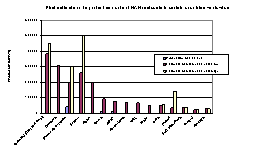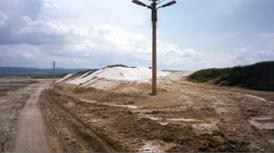The Legacy of Lindane HCH Isomer Production A Global Overview of Residue Management, Formulation and Disposal
Objective
IHPA has made an effort to bring the global problem HCH waste under the attention of the international society and calls for international action to tackle this serious environmental forgotten problem.
Summary (Further details can be found in the IHPA library for downloading)
This report describes the various aspects of the production, management, formulation, storage and disposal of hexachlorocyclohexane (HCH) isomers with particular emphasis on the alpha, beta, delta and gamma (Lindane) isomers.
The production of Lindane is inefficient as for each ton of Lindane 8-12 tons of isomers are produced. These isomers have ended mostly as hazardous waste which were wildly and uncontrolled dumped at many places in the world. Although attempts have been made to use these residuals for the production of TCB, HCl and other derivates most of the attempts have been unsuccessful.
A global review has been made, in order to estimate the global amount of HCH-isomers. Two approaches have been used for the estimates.
The first approach is based on the collection of information from production sites, production capacities and produced amounts and information on waste amounts occurring. This is a kind of minimum approach as a number of sites are still unknown and if known the information is, specifically from the 50s and 60s, very difficult to access and often lacking.
By collecting data on production an approach has been made to estimate the possible amounts of residuals. For each ton of Lindane produced around 8 tons of HCH-residuals was estimated.
In Annex III, an overview has been made of all information collected of the various countries. The overview is not claimed to be complete, but a first rough indication on the situation. From these numbers first indications on total amounts of HCH-residuals has been established. These assumptions have been gathered in the following Figure. One of the major cases is shown too.
 |
 |
The second approach is based on the collection of usage data and its evaluation with the help of the works from experienced scientists in the field of POPs and HCH monitoring like Breivik, Holoubek, Li and others, used in the international models which was then supplemented with other data acquired. In close cooperation, Yi-Fan Li and undersigned have made a report on the global Lindane use. In this report global and continental estimates have been made.
The second approach based on usage data as described in Annex V resulted in the following data. An overview of usage data per continent is indicated.
Lindane usage in different continents from 1950 to 2000.
| Continent | Usage (kt) | Percentage |
| Europe | 287.16 | 63.32 |
| Asia | 73.20 | 16.14 |
| America | 63.57 | 14.02 |
| Africa | 28.54 | 6.29 |
| Oceania | 1.032 | 0.23 |
| Total | 435.50 | 100 |
It is estimated that global Lindane use for agricultural use amounts to around
450 000 tons for the period from 1950 to 2000. Additional use of Lindane on livestock, forestry, human health and other purposes has also to be considered and for the total global use around 600 000 tons has been estimated.
On that base a simple calculation on the total amount of possible residuals (factor 8 assumed for each ton of Lindane produced) 4.8 Mio tons of HCH-residuals could be present on the globe.
Summarizing, both approaches can give a good first estimate on the range of the total HCH-residuals problem varying from 1.7-1.9 Mio to 4.8 Mio tons.
